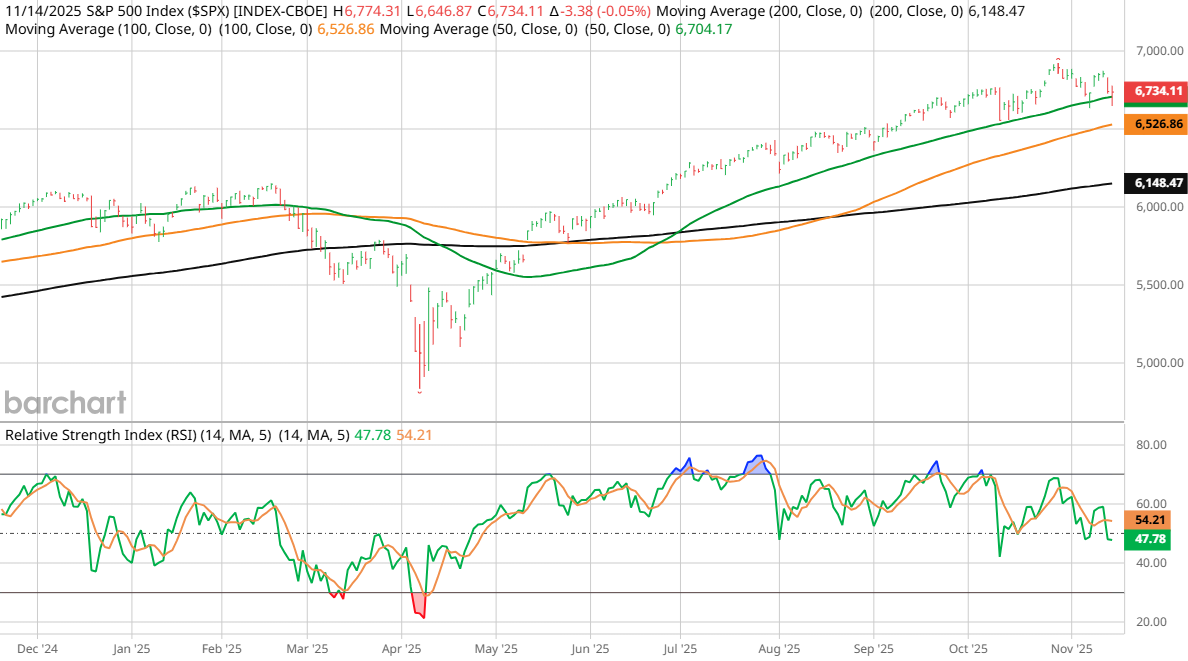Investors are experiencing a familiar sense of pressure as the screens turn red once more. A couple rough days in the market can undo weeks of confidence and I've seen it happen more times than I care to admit. You think you’re calm until the drawdown shows up before breakfast. Then the questions start piling in. Do you protect what you have left? Do you wait for the bounce? Do you cut the loss before it turns into something much worse? I have watched fund managers freeze on the exact same screens and I have seen private investors throw away years of disciplined work because a pullback rattles them into making the wrong move at the wrong time.
For as long as markets have existed, they have pulled back. They always will. And most of the time, they come back. Some of the best moves I’ve seen in my career came right after weeks when everyone felt sick. The real issue is never the pullback. The real issue is how you respond during the pullback. If you react emotionally, you hand whatever edge you worked so hard to build right back to the crowd. If you respond with structure, you position yourself for the next run. Your advantage right now does not come from guessing bottoms. It comes from the discipline to choose correctly when things feel uncomfortable. That decision separates a setback from an opportunity.
Why Investors Freeze During Pullbacks
When the market turns red, loss aversion takes over. The pain of a loss is twice as strong as the pleasure of a gain. You know that. I know that. Yet it still pushes investors into emotional corners. I have seen people stare at their entry prices as if they were sacred. They wait for the stock to “come back to that level,” as if the market even knows or cares what number they anchored to. That hesitation kills decision-making. It becomes paralysis disguised as patience. Professionals don’t do that. They do not negotiate with the past. They reprice risk the way a chess player resets a board, without caring how the last game ended. They look at the structure now, not the memory of what it used to be. The market does not care where you bought it. It matters where the structure is going.
What the Pullback Is Really Telling Us
Red tape across the screen is never random. It reveals the segments of the market that were already under pressure. Leadership weakens before the story does. I’ve seen this play out in everything from industrials in 2015 to software in 2021. Liquidity thins out. Crowded trades start to wobble. And suddenly everyone is forced to reevaluate their positioning, not because of panic but because the market stopped offering cover.
But what shocks people is how many fundamentals stay perfectly intact underneath. A pullback doesn’t mean companies turned disastrous overnight. It simply removes the excess that narrative built around them. The smart investors I know treat these moments like stress tests. What held up? What cracked? Which positions were founded on actual structural value? Which ones were riding on noise and comfort?
A pullback is not a forecast. It is a reset. It tells you exactly what was real in your portfolio and what was wishful thinking.
Professionals do not sell everything and hide in cash. They move with intention. They raise selective cash by trimming weak structures, not strong ones. If the business has been deteriorating internally, it's time to let it go. They also tighten stops on names that ran far beyond their fundamentals. I’ve done this countless times, even on winners I loved. A great business can still be in a bad position if the market priced in too much too quickly. Investors often scale out of crowded trades. I have witnessed bull-market favorites transform into liquidity traps as soon as the market conditions change. Investors who remain invested due to past performance often find themselves at the mercy of a sudden surge in market volatility. Professionals do not get paid for holding winners forever. They get paid for protecting the gains those winners delivered.

What To Do With Losing Positions
Losing positions necessitates unwavering honesty. Each loss falls into one of two categories.
- The first is the broken thesis. This is where something fundamentally changed. The catalyst died. The economics shifted. Management stumbled. These positions do not come back just because they hurt to let go. They must be closed.
- The second category consists of stocks that have a broken price but maintain an intact investment thesis. The stock moved against you, but the business did not. Everything you believed still holds. Insiders are still buying. Cash flow still improves. The catalyst still stands. These you can hold or add to.
The hardest part is telling the difference, and that requires stripping out emotion. A loss does not define you. Refusing to define the loss does.
The Reset Most Investors Skip
Most investors stare at their portfolio during pullbacks and hope the bleeding stops. Professionals re-underwrite every single holding. They ask the only question that matters: would I buy this today at this price? If the answer is no, they should not keep it. Would I enter right now? Is the next catalyst still real? Is volatility hiding a better chance somewhere else? These questions pull the emotion out of the decision. They bring the discipline back. This reset is where professionals widen the gap between themselves and retail investors. The edge is rarely earned in the rebound. It is earned right here.
Where The Real Opportunities Appear
Pullbacks are not only defensive moments. They create the best buying windows of the entire cycle. Forced sellers show up. ETFs rebalance mechanically. Margin calls rip through crowded trades. And successful businesses get dumped for reasons that have nothing to do with their fundamentals. I have found some of my best ideas during these periods. Some spinoffs were discarded before anyone had a chance to read their filings. Debt-free companies that traded like distressed assets due to their placement in the wrong ETF have also been overlooked. Structural alpha setups began to form quietly while the market chased noise elsewhere. Volatility doesn’t destroy opportunity. It is handed to those who are ready.
Most investors react after the rebound. They chase what has already moved. They buy what just bounced. Professionals build the plan beforehand, so they act with clarity when others act with emotion. Define your buy list now. Decide which losers you will cut and which you will keep. Set concrete price levels where you will deploy capital. And commit to a process that remains consistent regardless of your emotions. Despite gathering data, I have seen investors lose because they lacked the necessary preparation to act. The key distinction between a professional and an amateur lies in their level of preparation, not the information they possess. It is preparation.
The Emotional Trap To Avoid Now
The biggest mistake in a pullback is trying to “get back to even.” I have seen investors destroy perfectly excellent portfolios by pouring more money into the positions that hurt them, simply because they wanted emotional closure. Waiting too long is just as dangerous. The recovery arrives quietly and then moves quickly. If you hesitate, you miss it. Pullbacks create frustration and doubt. They bring out the urge to fix the feeling instead of fixing the process. But these moments are also when clarity comes back. A pullback strips away illusion. This situation reveals the value of your investment. The investors who treat the pullback as a reset will come out stronger. The ones who freeze will repeat the same mistakes in the next bout of volatility. Opportunity slips quietly, but it slips by. Your portfolio does not need a hero. It needs structure, discipline, and a plan. The market has always rewarded that combination.
On the date of publication, Jim Osman did not have (either directly or indirectly) positions in any of the securities mentioned in this article. All information and data in this article is solely for informational purposes. For more information please view the Barchart Disclosure Policy here.
More news from Barchart
- The Market Just Pulled Back. Here Is How To Protect Gains And Reset Risk
- NVDA Earnings, FOMC and Other Key Things to Watch this Week
- Nvidia's Earnings Report Will Be Out on Wednesday, Nov. 19 - How to Play NVDA Stock
- Nvidia Has One of the ‘Largest’ Opportunities Ahead. Should You Buy NVDA Stock Before November 19?






